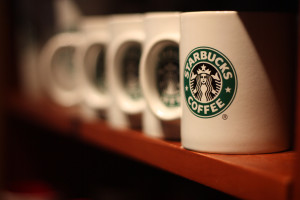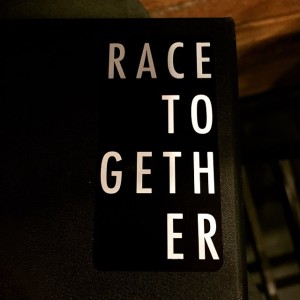#RaceTogether: Brewing Dialogue
Posted: March 27, 2015, 4:51 p.m.
by Sadie Schwarm.
Starbucks’ annual revenue has more than tripled over the past 10 years and reached $16.5 billion in 2014. A survey conducted last spring revealed that nearly 32 million Americans visited a Starbucks within 30 days before completing the survey.
Within the coffee chain industry, Starbucks generates the most revenue and has 21,366 stores worldwide, outnumbering all other coffee chains. So, it’s no surprise that Starbucks radiates widespread popularity.
 Avid coffee drinkers, ranging from everyday students to businessmen and all people in between, flock to their local Starbucks chain to order an Iced Caramel Macchiato or a Cool Lime Refresher. The coffee shop is a hangout – a comfortable one, nonetheless. The relaxing atmosphere of Starbucks provides an appealing environment where people can go to effectively complete work or to merely sit back and relax.
Avid coffee drinkers, ranging from everyday students to businessmen and all people in between, flock to their local Starbucks chain to order an Iced Caramel Macchiato or a Cool Lime Refresher. The coffee shop is a hangout – a comfortable one, nonetheless. The relaxing atmosphere of Starbucks provides an appealing environment where people can go to effectively complete work or to merely sit back and relax.
However, the company’s #RaceTogether initiative generated controversy rather quickly because of the tension it brought to the counter. Starting March 18, baristas were called to write “race together” on cups in the same manner as they write your name after you place an order, but this initiative did not last long.
On March 22, news broke that Starbucks will no longer be writing “race together” on any cups. Originally, the #RaceTogether initiative was meant to spark conversation about race relations and ethics, but many customers and employees thought this was crossing a line for the coffee chain and was not expected from the company’s brand.
 Starbucks has a history of caring about social and political issues. The CEO of Starbucks, Howard Schultz, wrote a letter sent out to employees regarding the current uproar of criticism.
Starbucks has a history of caring about social and political issues. The CEO of Starbucks, Howard Schultz, wrote a letter sent out to employees regarding the current uproar of criticism.
Schultz acknowledged the disapproval of the initiative. “We didn’t expect universal praise,” Schultz said. “We leaned in because we believed that starting this dialogue is what matters most. We are learning a lot.”
Race has been a plentiful topic in the news the past few years, and Schultz is promoting an open dialogue. Though writing “race together” on the cups has come to a halt, Schultz made it clear that the initiative has not ended. According to an article by NPR, Starbucks plans to open new stores in communities with large minority populations and hire 10,000 disadvantaged youth over the next three years.
Some people see this open discussion as a marketing ploy and not a whole-hearted initiative for the betterment of society, and others think #RaceTogether has not been successfully executed.
I think most of us can agree that in light of current events regarding race, discussion is necessary, but the question is where and when. Is the right location and time below the rim of your coffee cup on your morning stop before work? Some people may want to wake up and indulge in intellectual conversation about race, but I’d say most people don’t, even though the initiative has good intentions.
Other companies like Chipotle agree. Chipotle has a much more subtle way of getting messages out. It uses images in tune with Chipotle’s brand. The designs on the cups and bags have original literary pieces from popular authors. Instead of a flat, bold statement, the company leaves it up to the customers to decipher.
At least in the midst of the Starbucks’ criticism, a memo sent out to employees addressed the tension that it created in the past week, but was the Race Together initiative a good move for the brand as a whole?
Ironically, Starbucks’ stock went up in spite of the backlash. According to NPR, last week the company’s stock started at 94.03 and ended Friday at 97.45; however, this increase does not mean that #RaceTogether was solely positive for the brand.
Only time will tell.




